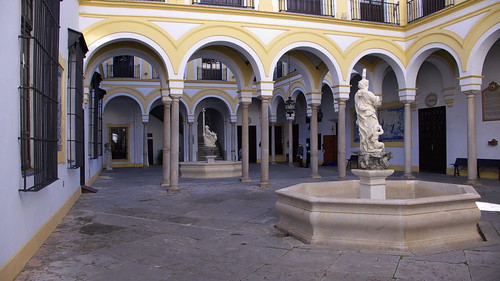Sunday 29 March 2009
The Feeding of the Five Thousand
Christ healing the Paralytic

Murillo's Christ Healing the Paralytic (Hermandad de la Caridad, Seville) represents one of the six Acts of Mercy. This picture shows a cause particularly relevant to the Caridad - the visitation of the sick. The illustration is taken from John's gospel.
"Now there is at Jerusalem by the sheep market a pool, which is called in the Hebrew tongue Bethesda, having five porches. In these lay a great multitude of impotent folk, of blind, halt, withered, waiting for the moving of the water. For an angel went down at a certain season into the pool, and troubled the water: whosoever then first after the troubling of the water stepped in was made whole of whatsoever disease he had. And a certain man was there, which had an infirmity thirty and eight years. When Jesus saw him lie, and knew that he had been now a long time in that case, he saith unto him, Wilt thou be made whole? The impotent man answered him, Sir, I have no man, when the water is troubled, to put me into the pool: but while I am coming, another steppeth down before me. Jesus saith unto him, Rise, take up thy bed, and walk."
The Return of the Prodigal Son

Murillo's Return of the Prodigal Son (Hermandad de la Caridad, Seville) depicts one of the six Acts of Mercy. Although usually associated with the key message of forgiveness, here it represents Clothing the Naked.
The Liberation of St Peter

Murillo's Liberation of St Peter (Hermandad de la Caridad, Seville) is from his series depicting the six Acts of Mercy. This one represents the ministering to prisoners. St Peter wears a blue tunic with a yellow mantle and sits in the middle of the prison floor, looking at an angel who takes his arm and points to a way of escape. Architecture and sleeping guards appear in the background.
Abraham and the Three Angels

Murillo's Abraham and the Three Angels at the Hermandad de la Caridad, Seville, represents one of the six Acts of Mercy: the taking in of strangers. Three angels advance from the left, dressed as pilgrims they hold staves. Abraham, in a turban, kneels before them amd indicates with his handshis own houseon the right, which he invites themto enter. It's relevant that this painting would be one of the first Acts of Mercy to be seen. It is a sign of welcome to newcomers to the church, an indication of the benevolence of the Brothers.
Who could join the Caridad?
"Then Moses cried out to the LORD, and the LORD showed him a piece of wood. He threw it into the water, and the water became sweet.
There the LORD made a decree and a law for them, and there he tested them. He said, "If you listen carefully to the voice of the LORD your God and do what is right in his eyes, if you pay attention to his commands and keep all his decrees, I will not bring on you any of the diseases I brought on the Egyptians, for I am the LORD, who heals you."
Forget the honours and status of life!

Can Mortality become Immortality?
 The title of this picture, translated means 'In the twinkling of an eye' and is derived from Paul's first letter to the Corinthians:
The title of this picture, translated means 'In the twinkling of an eye' and is derived from Paul's first letter to the Corinthians:"Behold, I tell you a mystery: We shall not all sleep, but we shall all be changed— in a moment, in the twinkling of an eye, at the last trumpet. For the trumpet will sound, and the dead will be raised incorruptible, and we shall be changed".
This shows that death can vanish in the twinkling of an eye, and mortality can become immortality - a note of hope therefore, in so doleful a painting. The sombre intent of this picture is enhanced by its colour scheme. The way the light loses intensity as the space goes back indicates the shadowy view of death held by mortals. The skeleton extinguishes the candle of life, intensifying the drama, dominating the picture, just as death conquers all earthly attributes. Emblems of power and wealth are all cast here in the shadow of death which makes them meaningless. Even non-material human achievements become worthless. The scholarly books - the writings of royalty, a prophet and Pliny - are just mere words of no interest to death who leers out of the picture with his shroud and scythe, more powerful than the armoury and rich cloth displayed around the coffin. Consolation may be found in the following from John:
"Just as Moses lifted up the snake in the desert, the Son of Man must also be lifted up. So that everyone who believes can have eternal life in him. God loved the world so much that he gave his one and only Son so that whoever believes in him may not be lost, but have eternal life. God did not send his Son into the world to judge the world guilty, but to save the world through him. People who believe in God's Son are not judged guilty".
Worldly aims are futile and Death is inevitable!

God saved you by his grace when you believed. And you can’t take credit for this; it is a gift from God. Salvation is not a reward for the good things we have done, so none of us can boast about it. For we are God’s masterpiece. He has created us anew in Christ Jesus, so we can do the good things he planned for us long ago".
A spectacle of Death in Seville!

